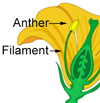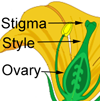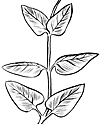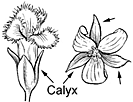African Tulip Tree
Spathodea campanulata
Bignonias family (Bignoniaceae)
Post-Cook introduction
This handsome ornamental and shade tree is planted for its showy masses of large brilliant orange-red to scarlet tulip-like flowers in erect clusters mostly at top of A prolific seeder, as well as a root sprouter, the species has become naturalized.

©2012 Barry Rice
Leaves or sometimes in threes, large, 1–2 ft (30–61 ) long. usually 11–17 (sometimes 5–19), paired except at end, 3-6 inches (7.5–15 ) long and 1 1⁄2–3 inches (4–7.5 ) broad, on short stalks of 1⁄8 inch (3 ), abruptly short-pointed, rounded and slightly oblique at base, a little thickened with edges a little turned under, almost hairless, upper surface green to dark green with sunken veins and slightly shiny, lower surface rusty hairy.
Flower clusters () about 4 inches (10 ) high and 8 inches (20 ) across. Flower buds are numerous, crowded, horn-shaped, 1–2 inches (2.5–5 ) long on stout greenish stalks of the same length, orange brown, curving inward to the center. Those around outside open a few at a time and drop off about two days later. The flowers have a most unusual flattened shape, with light brown 2–2 1⁄2 inches (5–6 ) long, curved and pointed like a horn, splitting open on the outer side, minutely hairy and with longitudinal ridges. The tubular orange-red to scarlet about 4 inches (10 ) long and 2 by 3 inches (5 by 7.5 ) broad has an enlarged bell-shaped tube 2 inches (5 ) across and curved downward and five broad unequal with crisp wavy edges narrowly bordered with gold. There are four pale yellow 2–2 1⁄2 inches (5–6 ) long, with dark brown inserted in the tube in 2 pairs and projecting barely beyond. The on a consists of an oblong two-celled 1⁄4 inch (6 ) long, a long slender curved, pale yellow about 3 inches (7.5 ) long, and two- red
Pods (capsules) one to several, large lance-shaped or boat-shaped, green to dark brown, 5–10 inches (13–25 ) long, 1 1⁄2 inches (4 ) wide, and 7⁄8 inch (22 ) thick, slightly flattened, long-pointed, erect and pointing upward from stout stalks, splitting open on one side. Seeds numerous, very thin and papery, with a light brown center bordered by a transparent 1⁄2–1 inch (13–25 ) across. Flowering and fruiting probably through the year.
Wood is very lightweight, soft, whitish yellow, without distinction between sapwood and heartwood, very brash and coarse-textured. The wood is not utilized in Hawaii.
This ornamental and shade tree is propagated by seeds, cuttings, and root cuttings. It grows very rapidly but requires nearly full light. Measured trees in Puerto Rico increased in trunk diameter as much as 2 inches (5 ) a year. As trees are broken by high winds and frequently become hollow and hazardous in age, planting near buildings or along roads is not advised. Also, the superficial root system makes this species undesirable for planting near houses and sidewalks. The trees produce sprouts from the roots, sometimes becoming like weeds. This species has been tried elsewhere for coffee shade but is not recommended for that purpose. Unopened flower buds contain water, ill smelling and tasting, which squirts out when the buds are squeezed, pinched, or pricked with a pin. The name “fountain tree” has been suggested by this character. Children play with these buds like water pistols. Old dry empty pods when widely open make very realistic toy boats, which, however, close up in water.
Planted and naturalized in the lowlands of Hawaii. It was aerially seeded in the Panaewa and lower Waiakea Forest Reserves near Hilo in 1928 and occupies much of the forest in the area seeded. The Division of Forestry has planted more than 30,000 trees in the forest reserves, mostly on Maui and Hawaii.
Special areas
Waimea Arboretum, Foster, Tantalus, Waiakea
Champion
Height 83 ft (25.3 ), c.b.h. 15.5 ft (4.7 ) spread 56 ft (17.1 ). Kainaliu, North Kona, Hawaii (1968).
Range
Native of tropical West Africa. Widely planted in tropical regions around the world, including southern Florida and Puerto Rico and Virgin Islands.
Other common names
tuliptree, fountain-tree, firebell, spathodea; tulipan africano (Puerto Rico, Spanish); rarningobche (Yap).
Botanical
Spathodea nilotica Seem.
The first trees were introduced into Hawaii apparently by Hillebrand more than a century ago, according to Degener. About 1915, Rock brought seeds from Java. A horticultural variety with golden yellow flowers is a recent introduction and provides some variation in color. It has been named for the late Lester W. “Bill” Bryan, who served for 40 years with the Territorial and later State forestry staff in Hawaii until his retirement in 1961 as Deputy State Forester







